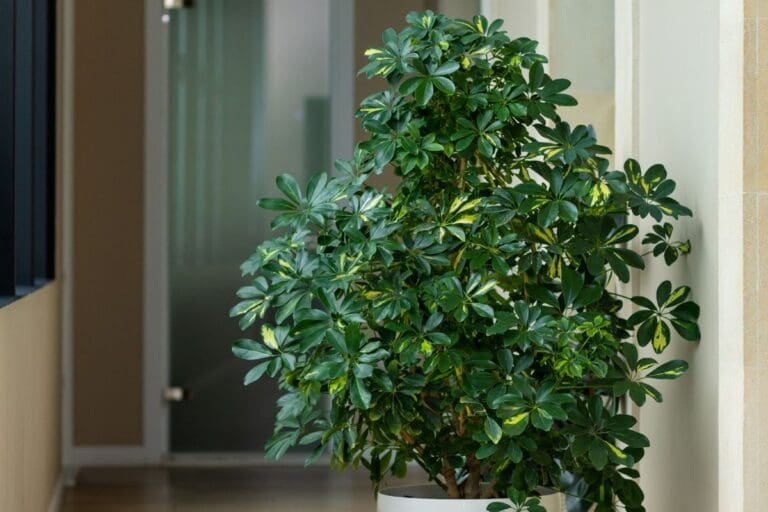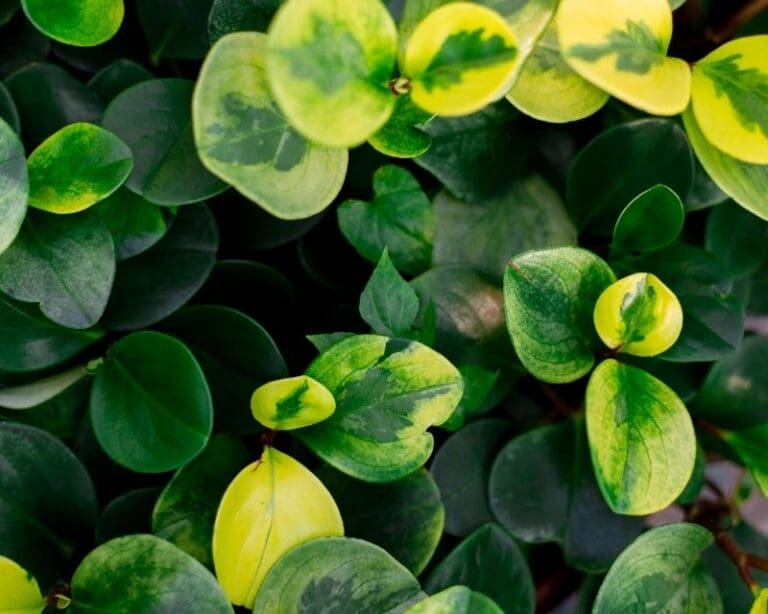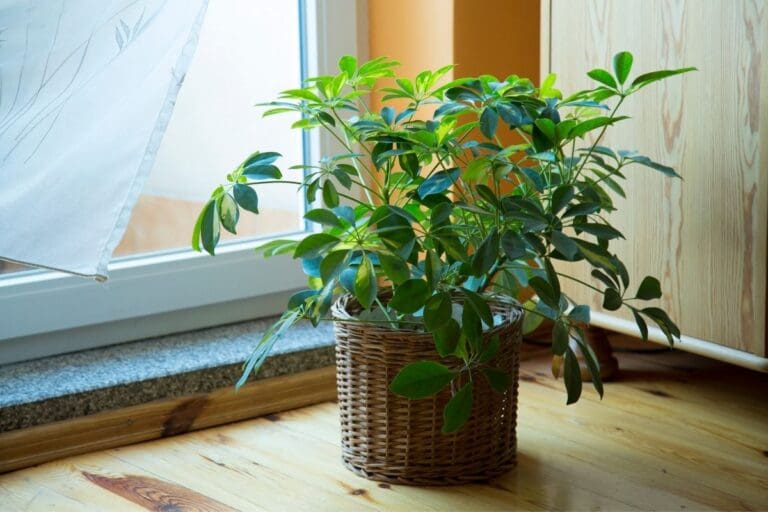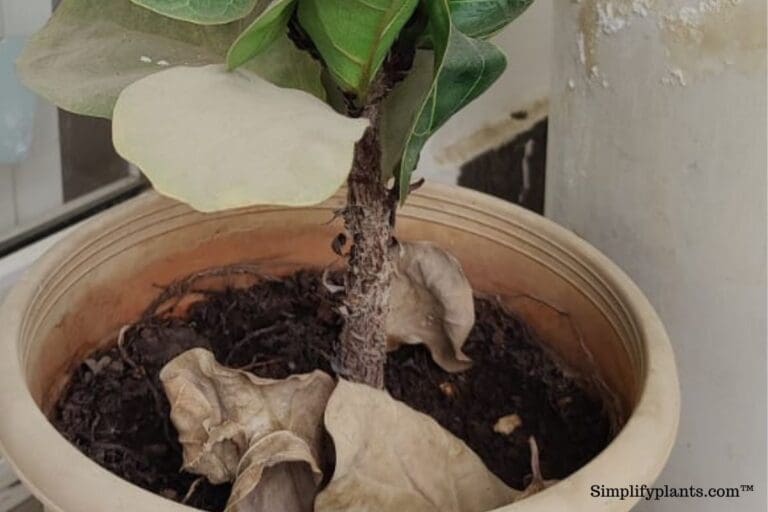Schefflera Pest Problems: Common Pests & Diseases+How To Fix
Schefflera also known as umbrella tree is a low-maintenance tropical plant grown as houseplants in various climates. Though these plants are easy to grow, don’t get shocked to find pests or diseases.
Pests like mealybugs, fungus gnats, and scales commonly infest a Schefflera plant. If you see any pests, isolate the plant, prune the heavily-infested part, and apply neem oil or insecticidal soap to the infested part. To prevent pest problems, provide your umbrella plant with the ideal conditions.
I will discuss the essential details you must know about the various pests and diseases that attack your umbrella plant, help you deal with them, and give tips to prevent them.

Please note: Simplify Plants is reader-supported. Some links in the post are affiliate links and I get a commission from purchases made through links in the post.
What are the common pests on Schefflera plants?
Despite being a hardy, low-maintenance plant, Schefflera is often attacked by nasty pests that damage your plant if left unchecked.
There had been occasions when I found my umbrella plant looking feeble and wilted, and that is when I checked for pests immediately.
In this article, I have mentioned all the details of how you can deal with different pest problems and diseases with the help of my experience.
These creepy pests attach themselves to the leaves and branches and suck out necessary nutrients from the plant.
Unfavorable conditions like extreme dampness, overwatering, or low humidity can encourage pests to attack your plant.
Let us discuss some of the most common bugs that attack your Schefflera.
Mealybugs

These are nasty pests that destroy the plant and are hard to kill.
They are tiny, white, waxy insects that attack the Schefflera, sucking out the sap with their tube-like mouth.
After feeding on the plant, they secrete a sticky substance called honeydew, attracting ants.
They cause the plant to wilt and turn yellow, stunt its growth, and begin to weaken the plant’s roots if not treated.
Fungus gnats

These are dark brown colored tiny flies that are primarily found in groups around the plants due to overwatering.
Due to their color, it isn’t easy to spot them, so when you want to catch them, you have to shake the plant a little, and they will fly out, buzzing around the Schefflera.
The larvae of these gnats pierce the roots of the Schefflera by moving inside the soil, feeding on them, and wounding them.
If not checked, they can damage the roots, making them vulnerable to other pests and diseases.
Spider mites

Your Schefflera can be prone to spider mite attacks when it doesn’t get enough moisture or humidity.
Spider mites are tiny bugs that are almost invisible to the eyes.
They can be found on the leaves undersides and suck the sap from the plant’s veins.
One of the early signs of this infestation is little white dots on the underside of leaves.
These mites spin webs around the plant’s body, and ultimately the leaves fall off.
Aphids

These are oval-shaped insects with piercing mouths and can be of multiple colors like white, yellow, green, and brown they are attracted to moist conditions.
So overwatering and low light are the primary causes of aphid attacks.
They attack the tender tissues of the plant, like the leaves and stem and suck the sap from them.
They cause the leaves to curl up and turn yellow.
When left untreated, they multiply in numbers, ultimately overpowering the plant.
They excrete honeydew, which attracts black mold fungus, gradually turning the plant black.
Scales Insects

Another insect that feeds on Schefflera plants is the scales.
They are of various types, but the brown scales are the most common.
While feeding, they are immobile and can often be mistaken as tiny bumps or irregular growth on the plant’s leaves. They are tough to remove.
They cause the plant to stop growing and get yellow and wilt.
Caterpillars

Caterpillars attack outdoor Schefflera plants mostly and are easy to spot.
The larvae that are hatched on the plant eat the leaves.
This causes the leaves to appear to have ragged holes and edges.
Snails and slugs
Snails and slugs also disturb the Schefflera.
They hide during the daytime because they cannot tolerate the hot sun, and they come out and feed on your umbrella plant at night.
They like moist conditions and avoid bright light.
How do you get rid of pests on the Schefflera plant?
Now that we have discussed and identified the various bugs that disturb your Schefflera plant, we will discuss ways to eliminate them.
These pests spread rapidly, so it is essential not to delay the treatment procedure.
Once the number of bugs is multiple, it can get difficult to treat them.
Let us discuss the solutions to overcome pest infestations.

Isolate your umbrella plant from the others
The first step toward treating your bug-infested plant is to isolate it from the rest.
Bugs tend to spread very quickly.
From one plant, they can spread to the rest in no time.
So firstly, move the plant away from the other plants so that the bugs cannot spread.
Cut off the infected leaves and branches.
If bugs have overcrowded certain plant areas, it is best to trim them so that the pests do not spread to the other parts.
Always use clean sterilized pruners for pruning and sterilize them again after use.
But make sure not to cut more than 25% of the leaves.
Otherwise, you will put the plant under stress.
Wear gloves before pruning, as the calcium oxalate crystals in the plant’s sap can irritate the skin.
Start the treatment
Now it is time to start removing the pests from your plant.
For this, there are two methods.
One is by using organic pesticides, and the other is chemical pesticides.
For houseplants like Schefflera, it is recommended to use organic methods first because they do not harm the plants and are environment-friendly.
If you see ineffective organic methods, you can start with chemical pesticides.
Handpick the pests if they are few in numbers
Do not forget your gloves before beginning the treatment.
You can pick and remove the pests if there are fewer pests.
However, if they are too many, it will not be possible.
Wash the umbrella plant in running water
You should do this in the daytime only.
Wash the Schefflera with water focusing on the undersides of the leaves.
Use a hose for that, as it helps to put pressure on the leaves, which removes the bugs sticking to them.
Once you have washed the leaves and stem very well, keep it at a spot with a bright light and let the soil and the plant dry.
If you still find pests, you need to apply more methods.
Use a rubbing alcohol solution.
Rubbing alcohol removes bugs and pests from plants.
For this, you need the following:
- 3 parts water
- 1 part of rubbing alcohol
Mix this solution well, spray it all over or dip cotton, and dab it over the infested areas.
It will clear all the sticky pests from the Schefflera.
Use insecticidal soaps
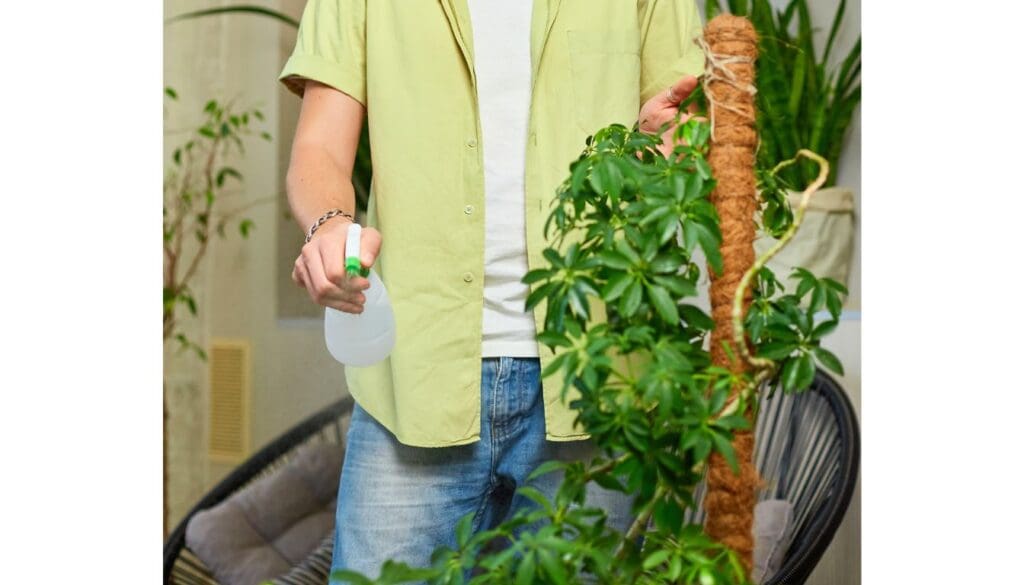
These are a great practical way to remove pests from plants.
As these are organic, they will not harm your plant either.
To use this, you need:
- 1 tbsp. of liquid soap
- 4 cups of water
Mix this well and spray it on the plant once every week until you see the infestations clearing.
Insecticidal soaps are also readily available in the markets.
Do this during the late afternoon so that the light is not too bright and the air is not too hot.
This soap solution kills pests by impairing the cell membranes.
Rotenone
This is a very toxic pesticide, not just for bugs but also risky for humans.
Spray this once a week to remove these pests.
While spraying maintains a safe distance from the plant, it can be harmful to the eyes otherwise.
Sticky traps
These are effective in trapping flying insects like aphids and gnats.
They are available online and in greenhouses, or you can make them at home with petroleum jelly and yellow cardboard.
The pests get drawn to yellow, and the jelly traps them.
Ryania
This is extracted from the dried stem; you can dust it on your Schefflera to remove the bugs.
However, if you have pets at home, be careful not to let them come near them.
Pyrethrum powder
Pyrethrum powder can be applied directly to the Schefflera or diluted in water and sprayed all over the plant.
This has to be used multiple times until the bugs are all apparent.
The bugs get paralyzed by its effect and die.
Linalool/Limonene
If nothing else works, use linalool and limonene, as strong chemicals paralyze and kill the bugs efficiently.
Natural Remedies and Organic Solutions to get rid of Pests
Below are some natural remedies and organic solutions for treating your Scefflera:
Neem oil solution
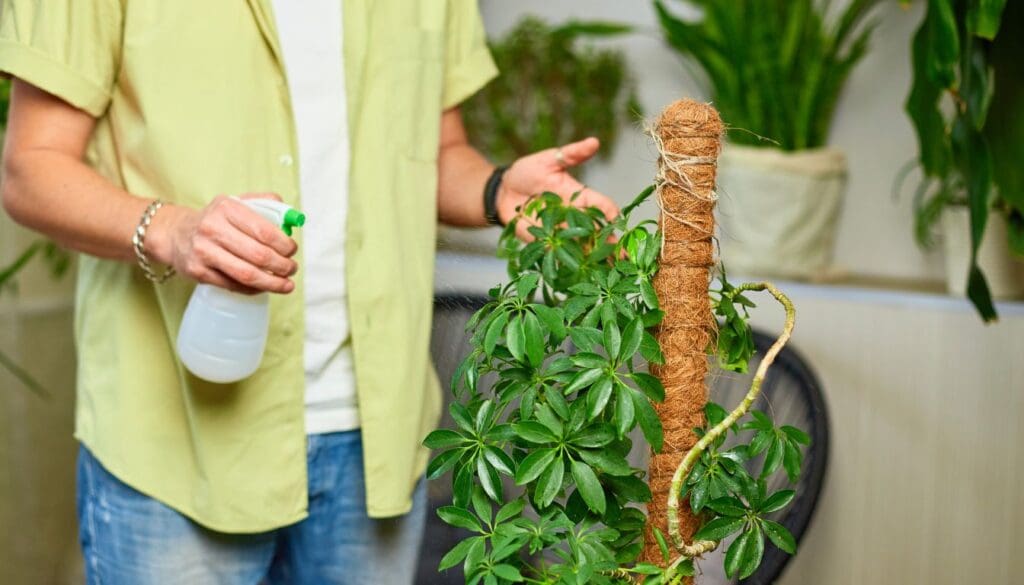
Neem oil is a popular and effective organic pesticide.
It kills the pests by damaging their hormones, preventing them from functioning normally.
As a result, they fail to feed and die.
It does not function on insects like scales with a rigid shield but effectively kills mealybugs and spider mites.
To prepare this solution, you need:
- 1 ltr. water
- 1 tbsp. dishwashing soap
- 1 tbsp. neem oil
You can also add some dish soap.
However, the solution is more effective by sticking itself to the plant body.
Spray the solution very well over your umbrella plant.
You have to keep spraying the solution continuously for a few days, and you do not need to wash it off after spraying.
Horticulture oil

You can use horticulture oil to remove the bugs if you do not have neem oil.
In extremely low or high-temperature regions, do not use this.
Diatomaceous earth
Organic insecticides like Diatomaceous Earth remove bugs without damaging the plant.
It restricts the movement of the pests and paralyzes them.
What are the common diseases of the Schefflera plant?
Schefflera plants are hardy and can prevent diseases if they get the correct growing conditions.
If left unchecked, these diseases can kill your plant.
When a disease-causing pathogen attacks, the plant’s growth rate slows down, the leaves become yellow and brown, and spots and marks become visible on the leaf.
Let us know about the few diseases that attack this plant.
Root rot
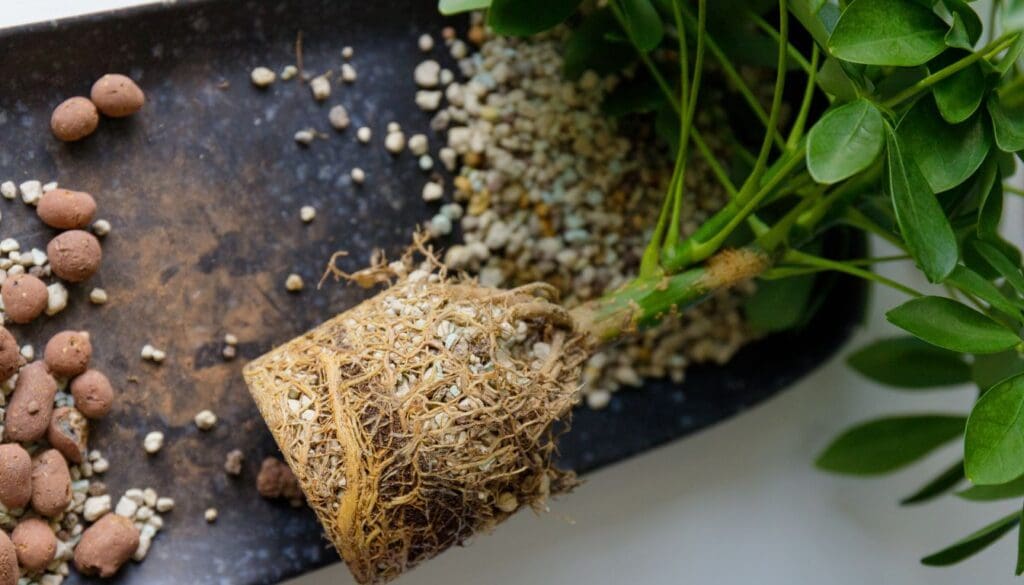
Root rot is a problem that Schefflera plants very often experience.
This plant can tolerate underwatering, but it hates overwatering.
The pathogens that cause root rot attack the plant’s roots when they stay soggy and wet for a long time.
If you constantly keep the soil of your Schefflera wet, these pathogens find a breeding ground to attack the roots.
When the roots stay soggy in water, the oxygen circulation decreases, and they can no longer breathe in the mud.
This blocks the airflow resulting in the birth of this disease-causing fungus that begins to rot the roots, ultimately killing the plant.
How to fix it?
Firstly you have to check the watering level.
Schefflera needs to lose well-draining soil and not heavy wet soil.
Do not water the plant until the topsoil is dry.
If root rotting has already been set, you must do this.
- Take out the plant from its pot gently.
- Wash the roots very well
- Trim off all the black-brown rotten roots
- Spray some fungicide on the healthy roots
- Prepare a fresh mix of soil, sand, compost, and perlite/vermiculite to keep the soil light and loose.
- Repot the plant in this new soil mix
- Water it thoroughly until it runs off the drainage holes, do not water it again until the soil is dry.
- Keep it in an area with bright indirect light.
Fungal and Bacterial diseases
Alternaria leaf spot is a common fungal disease with large, waterlogged black and brown spots with yellow halos around, spreading to the entire leaf in a few days.
Phytophthora leaf spots look similar to Alternaria, but it attacks the lower leaves first and then goes up.
Pseudomonas leaf blight is a disease that affects Schefflera plants.
These tiny water-soaked spots appear on the plant, making the leaves turn black and fall off.
Xanthomonas leaf spot also affects the leaf surface where tiny yellow lesions occur and gradually enlarge between veins resulting in pre-mature leaf dropping.
Chlorosis is another disease that attacks this plant when it gets too less light.
Low light weakens the plant’s drainage system and keeps the soil soggy.
How to fix it?
There are multiple fungicides and bactericides to manage these diseases; however, the Schefflera plant is sensitive to harsh chemical injuries.
Bacterial and fungal infections that affect the leaf surface spread quickly and often attack moist leaves.
The University of Florida reported that keeping the leaves dry prevents many diseases.
Cut away the diseased leaves and keep the leaves dry.
If you mist your Schefflera, always do it early so the foliage dries during the daytime.
To fix Chlorosis improve the lighting condition and drainage of the plant.
Schefflera Wilt Disease
Schefflera Wilt Disease can be fatal if left untreated. Here are the symptoms and control measures for Schefflera Wilt Disease:
Symptoms:
- Yellowing and wilting of leaves, starting from the tips and moving inwards towards the stem.
- Dark brown or black discoloration of the stem and roots.
- A general decline in the plant’s health, including stunted growth, leaf drop, and eventual death.
How to fix it?
- Remove Infected Plants: If you suspect that your Schefflera plant has Wilt Disease, it is essential to remove the infected plant immediately to prevent the spread of the disease to other plants.
- Sterilize Tools: You will need to sterilize the tools that have come in contact with the infected plant.
- Improve Drainage: Schefflera Wilt Disease thrives in wet and moist conditions, so it is necessary to improve soil drainage.
- Avoid Overwatering: Overwatering can lead to waterlogged soil, which creates the ideal conditions for the growth of the fungus. Water your Schefflera plant only when the top inch of the soil feels dry to the touch.
- Fungicide Treatment: Fungicides can control the spread of Wilt Disease. However, they are ineffective and may only be temporary solutions. Consult a professional gardener or extension service for recommendations on the best fungicide, and follow the instructions carefully.
- Plant Resistant Varieties: Some Schefflera varieties are resistant to Wilt Disease, such as Schefflera arboricola. Consider planting a resistant variety if you live in an area with prevalent Wilt Disease.
How to prevent pests and diseases in your Schefflera plant?
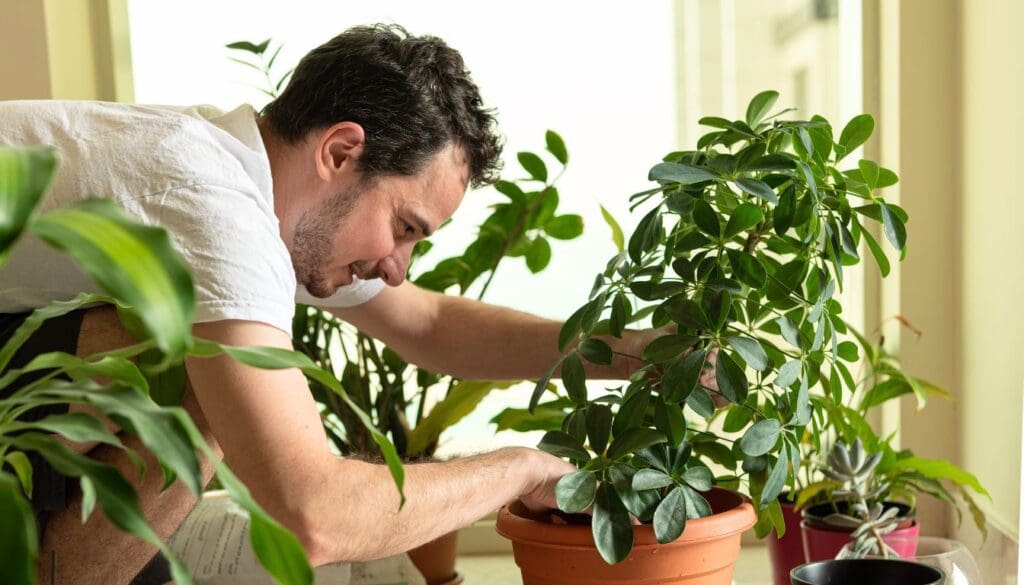
You can keep your Schefflera healthy by giving it the ideal growing condition and maintaining a few essential tips.
Let us discuss the points you must remember to help you grow your plant healthily:
- Schefflera plants need bright indirect sunlight. Do not keep the plant in a low-light area. Low light reduces evaporation rates, which also leads to overwatering issues. When the plant gets good light and airflow, it helps prevent many infections. If your plants do not get enough light, install artificial light to give them the necessary warmth.
- Do not overwater your plant in any condition. Schefflera is hardy plant and tolerates underwatering but not overwatering. Always check the soil with a moisture meter before watering, and water only when the topsoil gets dry.
- They prefer their soil to be light and loamy, and loose. Do not use the wrong potting soil to grow your plant. Heavy clayey soil holds a lot of water, resulting in fungus growth.
- Give the plant sufficient humidity, as much as it needs but do not overdo it. 60-70% humidity is sufficient for Schefflera. Use a hygrometer to measure if you are not sure. Using a humidifier helps in maintaining the correct balance.
- Do not mist your plant after sunset, as that will keep the plant wet for a long time.
- Keep the leaves of your plant clean to photosynthesize efficiently, preventing the growth of fungus.
- Do not keep the plant in an overcrowded corner. Make sure there is good airflow around the plant.
- Spray Neem oil solution once a month to keep the plants healthy and prevents bugs.
Final words

This article has explained all the necessary information regarding pests and diseases that can attack your Schefflera. If pests have attacked your plant, the above information will help you fix it. Following the above care tips can prevent bugs from attacking your plant.
To prevent pest and disease problems, I provide my Schefflera plant with adequate light, water, and fertilizer. I also regularly inspect my plant for signs of pests or diseases and take action as soon as I notice a problem.
Always try to use organic solutions to treat your plant if infected. Harsh chemicals should be your last resort.
Do Schefflera like to be misted?
Schefflera likes to be misted, so it is not a bad idea to mist them occasionally, especially when the weather is hot and dry.
Can Schefflera take full sun?
The direct sun might burn the leaves, so keep them in indirect light or shade. The occasional sun will not harm them.
Reference: Wikipedia, Sciencedirect, Britannica, American Society for Horticultural Science, Schefflera taxonomic history.
Recommended Garden Supplies
| Product Image | Our Recommended Gardening Supplies | Check Offers! |
|---|---|---|
Top Top
Top
Top
Top
Top
Top
Top
Top | rePotme Houseplant and Tropical Classic Potting Soil Mix | Check Offer On Amazon |
 Top
Top
Top
Top
Top
Top
Top
Top | Espoma Organic Indoor Plant Food | Check Offer On Amazon |
 Top
Top
Top
Top
Top
Top
Top
Top | GooingTop LED Grow Light 6000K Full Spectrum Clip Plant Growing Lamp | Check Offer On Amazon |
 Top
Top
Top
Top
Top
Top
Top
Top | Soil Moisture Meter | Check Offer On Amazon |
 Top
Top
Top
Top
Top
Top
Top
Top | Govee Hygrometer Thermometer, Bluetooth Enabled! | Check Offer On Amazon |
 Top
Top | LEVOIT Humidifiers for Large Room(Best For Plants) | Check Offer On Amazon |
 Top
Top
Top
Top
Top
Top
Top
Top | Upgraded DIY Automatic Drip Irrigation Kit, 15 Potted Houseplants Support | Check Offer On Amazon |
 Top
Top
Top
Top
Top
Top
Top
Top | Stainless Steel Heavy Duty Gardening Tool Set | Check Offer On Amazon |
 Top
Top
Top
Top
Top
Top
Top
Top | Bonide Insecticidal Soap | Check Offer On Amazon |
 Top
Top
Top
Top
Top
Top
Top
Top | Bonide 32 oz Spray Neem Oil for Organic Gardening | Check Offer On Amazon |
 Top
Top
Top
Top
Top
Top
Top
Top | Garden Safe Fungicide | Check Offer On Amazon |

